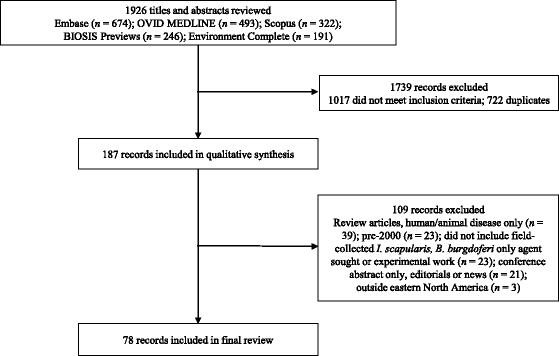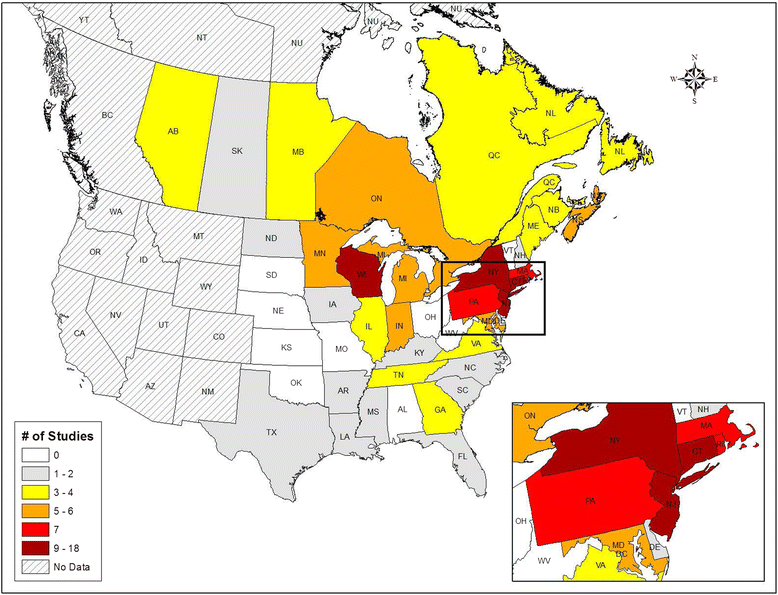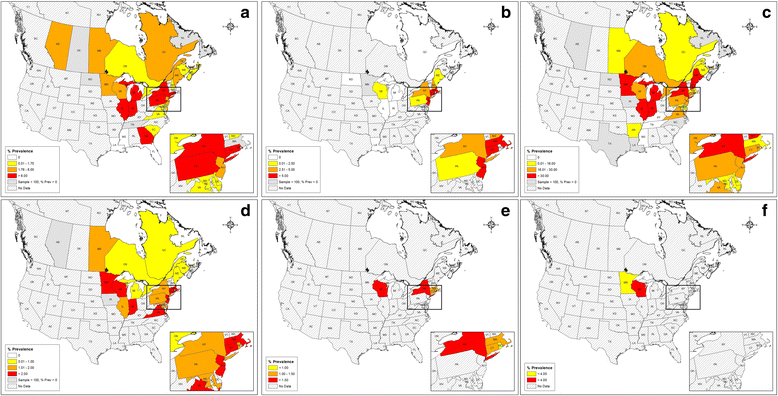Human pathogens associated with the blacklegged tick Ixodes scapularis: a systematic review
- PMID: 27151067
- PMCID: PMC4857413
- DOI: 10.1186/s13071-016-1529-y
Human pathogens associated with the blacklegged tick Ixodes scapularis: a systematic review
Abstract
Background: The blacklegged tick Ixodes scapularis transmits Borrelia burgdorferi (sensu stricto) in eastern North America; however, the agent of Lyme disease is not the sole pathogen harbored by the blacklegged tick. The blacklegged tick is expanding its range into areas of southern Canada such as Ontario, an area where exposure to blacklegged tick bites and tick-borne pathogens is increasing. We performed a systematic review to evaluate the public health risks posed by expanding blacklegged tick populations and their associated pathogens.
Methods: We followed PRISMA (Preferred Reporting Items for Systematic Reviews and Meta-Analyses) guidelines for conducting our systematic review. We searched Ovid MEDLINE, Embase, BIOSIS, Scopus and Environment Complete databases for studies published from 2000 through 2015, using subject headings and keywords that included "Ixodes scapularis", "Rickettsia", "Borrelia", "Anaplasma", "Babesia" and "pathogen." Two reviewers screened titles and abstracts against eligibility criteria (i.e. studies that included field-collected blacklegged ticks and studies that did not focus solely on B. burgdorferi) and performed quality assessments on eligible studies.
Results: Seventy-eight studies were included in the final review, 72 were from the US and eight were from Canada (two studies included blacklegged ticks from both countries). Sixty-four (82%) studies met ≥ 75% of the quality assessment criteria. Blacklegged ticks harbored 91 distinct taxa, 16 of these are tick-transmitted human pathogens, including species of Anaplasma, Babesia, Bartonella, Borrelia, Ehrlichia, Rickettsia, Theileria and Flavivirus. Organism richness was highest in the Northeast (Connecticut, New York) and Upper Midwest US (Wisconsin); however, organism richness was dependent on sampling effort. The primary tick-borne pathogens of public health concern in Ontario, due to the geographic proximity or historical detection in Ontario, are Anaplasma phagocytophilum, Babesia microti, B. burgdorferi, Borrelia miyamotoi, deer tick virus and Ehrlichia muris-like sp. Aside from B. burgdorferi and to a much lesser concern A. phagocytophilum, these pathogens are not immediate concerns to public health in Ontario; rather they represent future threats as the distribution of vectors and pathogens continue to proliferate.
Conclusions: Our review is the first systematic assessment of the literature on the human pathogens associated with the blacklegged tick. As Lyme disease awareness continues to increase, it is an opportune time to document the full spectrum of human pathogens transmittable by blacklegged ticks.
Keywords: Bacteria; Blacklegged ticks; Infectious disease; Ixodes; Parasites; Pathogens; Public health; Symbionts; Vector-borne; Viruses; Zoonoses.
Figures



References
-
- Leighton PA, Koffi JK, Pelcat Y, Lindsay LR, Ogden NH. Predicting the speed of tick invasion: an empirical model of range expansion for the Lyme disease vector Ixodes scapularis in Canada. J Appl Ecol. 2012;49:457–64. doi: 10.1111/j.1365-2664.2012.02112.x. - DOI
Publication types
MeSH terms
LinkOut - more resources
Full Text Sources
Other Literature Sources
Medical
Research Materials
Miscellaneous

